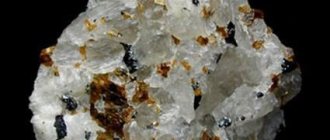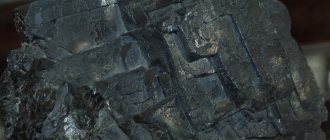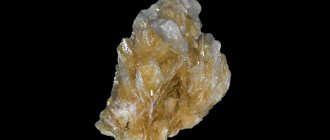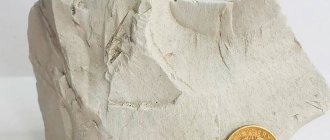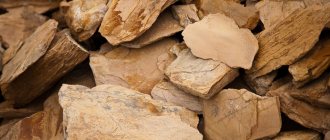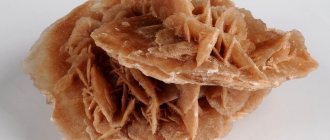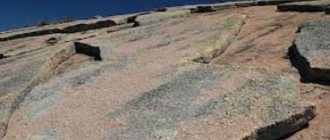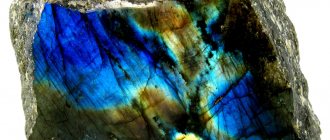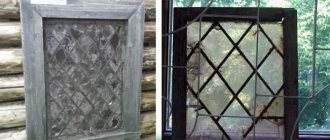Chemical composition
Chemical composition (in%): K2O from 7.0 to 10.3, MgO from 21.4 to 29.4. Al2O3 FROM 10.8 to 17 (according to the formula it should be 12.2), SiO2 from 38.7 to 45.0 (according to the formula it should be 43.2), H2O from 0.3 to 5.4, F to 6. The most commonly present impurities are FeO up to 9%, BaO up to 2.5% (baryophlogopite), Na2O up to 2%, as well as Fe2O3, sometimes MnO, CaO, Cr2O3, NiO, etc. The variety with a MnO content of up to 18% is called manganphlogopite (does not contain fluorine). The titanium-rich variety is called titanphlogopite. TiO2 obviously replaces the Mg[OH]2 group, since the sum of OH + F in molecular terms is half that expected for micas according to the chemical formula. The composition of phlogopite is sometimes complicated by a large number of gas inclusions (H2, CO, CO2).
Crystallographic characteristics
Syngony. Monoclinic.
Symmetry class . Prismatic - 2/m.
Axle ratio. 0.577: 1: 1.112; β =100°12′.
Crystal structure
Main forms:
The crystal structure of micas, as already indicated, is characterized by the fact that aluminum-oxygen tetrahedra (in the ratio Al : Si = 1 : 3) participate in the layers of silicon-oxygen tetrahedra. As a result, a residual negative charge arises between three-layer packets having the formula Mg3[Si3AlO10][F, OH], which is compensated by the monovalent cation K1+. Unlike other micas, in phlogopite, Mg ions are located inside layered packets between two aluminum-silicon-oxygen layers in all places of six-fold coordination. As in all micas, the layered packets lying one above the other are slightly displaced relative to each other, which determines the general monoclinic system of crystals. Detailed studies have shown that phlogopites belong to the type of single-layer 4-mica
Biotite phlogopite
Dear visitors and buyers!!! I would like to bring to your attention bracelets and a pendant made of a rare mineral - biotite-phlogopite. Biotite (odenite, iron mica) is a natural mineral belonging to the mica category. In thin plates the stone is transparent, sometimes translucent, while large biotite crystals have a glassy luster, but are not transparent. The color depends on the amount of impurities in the composition; it can be yellow, bronze, dark green, red-brown and black.
The mineral belongs to the group of aluminosilicates. The main elements in its composition are potassium, iron and magnesium, and their share in the total mass is not constant. A feature of the mineral can be considered a large number of impurities, which can be fluorine, sodium, lithium, barium, manganese, cesium, titanium and strontium. The stone is soft, has a low density coefficient, is susceptible to sulfuric acid, and is melted by candle fire. With prolonged exposure to sunlight, it loses its natural color, transforming into green chlorite or muscovite. Biotite has the following varieties: Bowerite (cat's gold) - a stone with a bronze color; Meroxene is a mineral with a small proportion of iron in its composition; Rubellan is a biotite with a rich red-brown color; Lepidomelan is a black stone saturated with iron oxide; Siderophyllite is a mineral of dark brown shades, reaching black, which includes a high percentage of iron with a minimal amount of magnesium; Glauconite (hydromica) are green crystals that have been transformed due to the influence of sea waters. Scientists classify this mineral as an independent group, considering it not a variety of biotite, but an independent unit. The magical properties of biotite depend on its shades. To attract profit and material stability, a piece of bronze-colored mineral is placed in the wallet. Green crystals bring spiritual comfort, and stones of pink and red tones contribute to the harmonization of family relationships. Enlightened magicians use biotite to communicate with higher powers, develop the gift of prediction, clairvoyance and intuitive sensations. With its help, you can discover the secrets of knowledge and get rid of energy blocks. Lithotherapists equate the healing properties of biotite with mica. It is believed to improve mental health, relieving stress, nervousness and uncertainty. Under its influence, sleep, blood sugar, hormonal levels and the immune system are normalized.
Biotite drives away depression, melancholy, stress and brings happiness to a person’s life. Biotite talismans are used to support the human psyche in critical or stressful situations. Can be used to relieve outbursts of anger and nervous tension. Improves flexibility in every sense and helps you look forward with joy and look back with gratitude for the lessons learned. Allows you to see yourself as others see you, and change the image that you present to the outside world. Supports during the experience of painful emotions. Mentally, this mineral is effective in solving problems and improves intelligence. Gives you the ability to clearly express your thoughts and feelings. Physically, it helps you look better and gives shine to your hair and eyes. Helps the body reach its optimal weight. Helps improve the condition of the endocrine, nervous, hormonal, lymphatic and immune systems, and has rejuvenating properties. Regulates blood sugar levels, pancreas and kidney function. It can be used to reduce hunger, for insomnia and allergies, and helps to recover from illness or stress. Since ancient times, marcasite has been used in the treatment of eye diseases. It counteracts cataracts and inflammatory processes in the mucous membrane of the eye, strengthens vision and is an excellent prevention of myopia. The mineral protects a person from infectious diseases, fever and tumors. Has a beneficial effect on the skin. Previously, marcasite powder was used to remove freckles and even out skin color, get rid of wrinkles and treat acne. Helps to cure warts, prevents the formation of moles, heals large wounds and ulcers. Restores the spleen and has a cleansing effect on the entire body. Thins the blood, increases the overall tone of a person, strengthens the immune system. Helps survive seasonal temperature changes. YOU CAN BUY HERE:
Form of being in nature
Phlogopite crystal Baikal region Slyudyanka
The shape of the crystals is tabular (pseudo-hexagonal), short-prismatic, sometimes truncated-pyramidal. The crystals are often roughly formed with pronounced parallel shading on the lateral faces. In shape they are indistinguishable from biotite crystals.
Doubles are common. In general, mica twins can be formed according to various laws. Most often there are those in which the twin plane is a plane perpendicular to (001) and passing along the (110) : (001) edge. Typically, individuals grow together along planes perpendicular to (001), so that the planes of cleavage pass from one individual to another without interruption. This is the so-called mica law of twinning. According to the same law, tees are also formed (a third grows to two individuals). Often in such tees, individuals germinate each other. In them, they often have a feathery structure relative to twin sutures, due to the fact that rectilinear thin folds or roughly pronounced strokes are located perpendicular to the (110) : (001) edge. Another law is called the chlorite law; in this case, the twin plane is (001).
Aggregates Dense, leaf-plate, scaly.
Physical properties
Optical
- The color of phlogopite is light, yellowish-brown or reddish-brown, less often colorless, silvery, sometimes with a greenish tint; dark brown in thick plates.
- The line is white.
- The luster is glassy, on the cleavage planes it is pearlescent with a golden or copper tint. The phenomenon of asterism is often observed, which is expressed in the fact that when examining the plate against the flame of an artificial light source, a bright six-rayed star is discovered.
- Transparency. Transparent, translucent.
Mechanical
- Hardness 2-3.
- Density 2.70-2.85.
- The cleavage is very perfect along {001}; imperfect cleavage appears along {110} and (010}, which are slip planes. These planes are clearly visible in the so-called impact figure, which is obtained for all micas on the (001) cleavage plane if a blunt needle is placed on it and sharply hit with a hammer As a result, systems of three intersecting lines diverging from the point of impact are formed, like a six-rayed star. Two rays are almost exactly parallel to the edges of the prism {110}, and the third, longest line is parallel to the plane of symmetry. If on a thick plate placed on something soft, press not with a needle, but with a ball or the rounded end of a cylindrical stick, then a pressure figure is formed, i.e., a six-rayed star with ray directions perpendicular to the ribs. These directions, compared to the impact figure, are rotated by 30°. Both figures are characteristic of all mica-like minerals .
- Thin sheets have elasticity.
Chemical properties
Decomposes in acids, especially sulfuric acid.
Other properties
It has very high ohmic resistivity and electrical insulator properties.
Artificial production of mineral
It is artificially obtained by crystallization of a fluorine-containing silicate melt corresponding to the composition of phlogopite by adding CaF2 to it (D. P. Grigoriev). In this way it was possible to obtain crystals up to 1 cm in diameter.
Diagnostic signs
Similar minerals. Muscovite, paragonite, biotite.
Associated minerals. Calcite, dolomite, serpentine, apatite, diopside, vesuvian, etc.
Light varieties of phlogopite are practically indistinguishable from muscovite in appearance, but the optical constants are different: phlogopite , like all other magnesium-iron dark micas, is optically almost uniaxial, while muscovite is clearly biaxial and has a large angle of optical axes.
It differs from biotite in its lighter color.
Story
Linguists believe that the name comes from the word “layer”.
The history of the mineral is connected with Russia:
- In Rus', he was called “sluda,” which was recorded in the Ostromir Gospel (1057).
- After 500 years, windows made of “Moscow crystal” could be afforded by nobles, merchants, and wealthy church parishes.
- By the 17th century, mica windows began to be painted like stained glass windows in Western European temples.
- Even more popular were lampshades, lanterns, mineral inlay boxes, and other household items.
- Mica plates were used to protect icons and decorate church utensils.
Mica, called muscovite (foreigners then called Russia Muscovy), was considered the best in the world.
Mining the mineral was a profitable business: 16-140 rubles were paid for a pood (16 kg). And, for example, a cow cost 4-5 rubles.
Windows were “glazed” with mica plates before the invention of real glass (18th century).
Mica instead of glass
In 1887, Russian scientist Konstantin Khrushchev created artificial mica - fluorphlogopite. In a number of characteristics it is superior to natural gemstones. Only special equipment can distinguish one from the other. The invention was useful during the Great Patriotic War.
The most remarkable object outside of Russia is the Mexican city of gods Teotihuacan. Its buildings are lavishly decorated with minerals that were brought here 5,000 km away.
Interpretation of the concept
This group of minerals has perfect cleavage in one direction. They are capable of splitting into very thin hard plates, while maintaining elasticity, flexibility and strength.
Thus, we can conclude that mica is a mineral that visually resembles glass and has a structure of layered crystals. It is due to this feature, as well as due to the weak connection between individual packages of materials, that certain chemical properties are formed.
Regardless of the fact that there are many varieties of the mineral in question, it has common characteristics, such as:
- lamellarity;
- basal cleavage;
- the ability to split into the finest components.
Versions about the origin of the name light mica
The first specimen of the mineral in question to appear in European civilization came from Karelia. Mica, the description of which was presented earlier, was exported to the West in significant quantities and was one of the main exported goods of our country in the 17th-18th centuries. Proof of this can be the origin of the name of light mica - muscovite - from the former name of the capital of the Russian state (XV-XVIII centuries) - Muscovy. Therefore, we can say that it arrived in Western markets from Russia.
According to the scientific version, the appearance of this name is considered to be the moment when, according to the double taxonomy proposed by such a Swedish naturalist as Carl Linnaeus, the German mineralogist Valerius assigned a certain name to industrial mica in the heading of the corresponding section, namely “Vitrum moscoviticum Wall”. Subsequently, only the central word from the proposed term was preserved in the system of double names.
Trade in antiquity
Origin and location
Quite often found in contact-metasomatic formations of willows in pegmatite veins cutting dolomitized limestones or other magnesian rocks poor in silica and iron (for example, serpentinites). Typical companions of phlogopite are diopside, forsterite, spinel, dolomite, calcite, feldspars, scapolites, etc.
Also common in metamorphic rocks (schists), usually in association with relatively iron-poor minerals. Without measuring optical constants, it can easily be mistaken for muscovite.
Mineral Change
Tetraferriflogopite with olifin and calcite Kola Peninsula
With the superposition of later processes, phlogopite is sometimes replaced by chlorites, sometimes it turns into talc. Under conditions of intense chemical weathering, hydration occurs, in some cases with the appearance of brown spots of iron hydroxides, and ultimately transformation into a clay product.
Deposits and methods of stone extraction
There are large deposits of mica in Namibia, Madagascar, USA, India, Canada, Brazil and Russia. Domestic deposits are located in Karelia, Yakutia, Irkutsk and Murmansk regions, Transbaikalia, the Kola Peninsula, and Taimyr.
The mineral at a depth of less than 100 m is mined using the open-pit (quarry) method. The mica rock is blasted or drilled, and quality sheets are selected by hand. Deposits at a depth of no more than 4000 m are obtained using a closed (mine) method. They make underground passages to the deposit, excavate the vein, loosen it with a drill or dynamite, and select stones by hand or with shovels.
In production, mica is synthesized - fluorphlogopite. Crystals are artificially grown from the same substances that are found in the natural mineral, and one chemical element is replaced by fluorine. They are grown at a temperature of 1400 ºC with a gradual decrease to 1200 ºC.
Synthetic mica is small-sized, dielectric, fire-resistant, and free of defects. It is suitable for small products, powder.
To watch a video from the blog about mining interesting stones:
Place of Birth
The Slyudyansk phlogopite deposits are located near Lake Baikal, near the station. Slyudyanka, Zabaikalskaya railway e. In a genetic connection with granite intrusions, numerous cutting pegmatite veins and metasomatic formations were formed here among a complex complex of crystalline schists, gneisses and marbles. Phlogopite-bearing mineral bodies are usually subordinate to pyroxene-amphibole gneisses and are often found in groups. The structure of such veins is quite complex. Diopside-phlogopite formations develop in the side rocks (regardless of their composition). Large-crystalline phlogopite is usually associated with diopside, scapolites, calcite, apatite and other minerals. The crystals often have barrel-shaped shapes, often with a sharp end, sometimes measuring up to 1.5 m in length. According to the color, the following varieties of phlogopite crystals are distinguished: 1) non-retin or with a yellowish tint, 2) silvery-white, mainly among limestones, 3) amber among aplite-like gneisses, 4) cherry or amber-red, 5) dark brown, sometimes with a golden tint , 6) dark green and 7) almost black among pyroxene-hornblende and biotite gneisses. When weathered, ferruginous phlogopites lighten and turn blue. Inclusions of calcite, scapolite and diopside are often observed among phlogopite crystals, and under a microscope, rutile is also identified in the form of the finest needles (saguenite), etc. Similar phlogopite deposits are common in the Aldan region of Eastern Siberia.
Phlogopite deposits in the province of Ontario (Canada) are found in approximately the same conditions in the form of veins and irregularly shaped nests. Phlogopite occurs in association with calcite, diopside and apatite in a wide variety of quantitative ratios. Phlogopite crystals reach 2 m in diameter. Amber coloration of phlogopite is the most common. Deposits of the same type are known in Madagascar, Ceylon, India, Korea, etc.
Phlogopite is a typical mineral of kimberlites (Yakutia), although many researchers consider it to be more recent, metasomatic. Phlogopite phenocrysts are known in some lavas (East Kimberley Australia)
Phlogopite mica, formed during the intrusion of granite pegmatites into hyperbasites, are known in the Emerald Mines (Sverdlovsk region, Russia). Vein-like mica were established in talc-carbonate rocks when exposed to an ultramafic granite massif (Kuznetsk Alatau)
Practical use
Phlogopite is used industrially in the same way as muscovite, but for some purposes it is preferred over muscovite. It is used in electrical switches because it wears out at the same rate as copper segments. It has great heat resistance and can withstand temperatures up to 1000oC. For industrial use, large crystals of phlogopite are obtained in laboratories, in which all OH ions are replaced by F, but the natural material is less expensive. The main suppliers of natural phlogopite are Canada and Madagascar.
